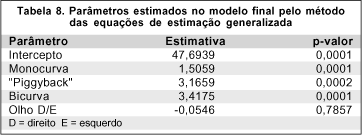PURPOSE: To determine associations between degrees of severity and topographical patterns of keratoconus with fitted contact lenses (CL). METHODS: Retrospective study of 454 patients (881 eyes) with keratoconus, 746 fitted with contact lenses, from July 1996 to June 2000. Keratoconus was classified according to degrees of severity and topographical pattern. The first tested contact lens was the spherical rigid gas permeable. When it did not achieve the desired fitting, the bicurve rigid gas permeable and other designs were tried, in search of an apical clearance or slight apical touch fitting relationship. RESULTS: For 15 (3.3%) patients glasses were prescribed; 111 eyes (12.6%) remained uncorrected; 746 (84.68%) eyes were fitted with contact lenses; for 39 eyes (4.44%) of 39 patients (8.6%) penetrating keratoplasty was recommended. The most common degree of severity found was advanced (575 eyes - 66.86%), followed by the mild variety (160 eyes -18.6%). The average keratometric value of the flattest meridian (K) was 47.80 (±3.73) for the eyes fitted with soft CL; 49.03 (±3.7) for the spherical rigid gas permeable contact lenses; of 51.62 (±3.6) for the bicurve contact lenses and 51.14 (±3.5) for the piggyback system. Concerning the topographical pattern, the most frequent was inferior peripheral cone (436 eyes - 50.7%), followed by central asymmetrical cone (348 eyes - 40.46%). In the right eye, the analysis of the variables, topographical pattern and kind of fitted lens showed a statistically significant association (p=0.045) of toric soft contact lenses and piggyback system with a higher percentage of fittings in central cone. Concerning the rigid spherical and bicurve lenses, the fitting percentage was similar in relation to the found topographical pattern. In the left eye, statistically significant associations were not observed, only tendencies. CONCLUSION: Spherical contact lenses can be fitted to the majority of patients with keratoconus, but it is important to rely on other designs to fit the advanced and severe cases. This allows most patients to postpone the need for corneal transplant. Toric soft contact lenses and piggyback system were more frequently fitted to central cones; whereas in inferior peripheral cones, spherical and bicurve contact lenses were those more used.
Keratoconus; Ocular accommodation; Contact lenses; Penetrating keratoplasty, Hydrophilic contact lenses; Corneal topography









